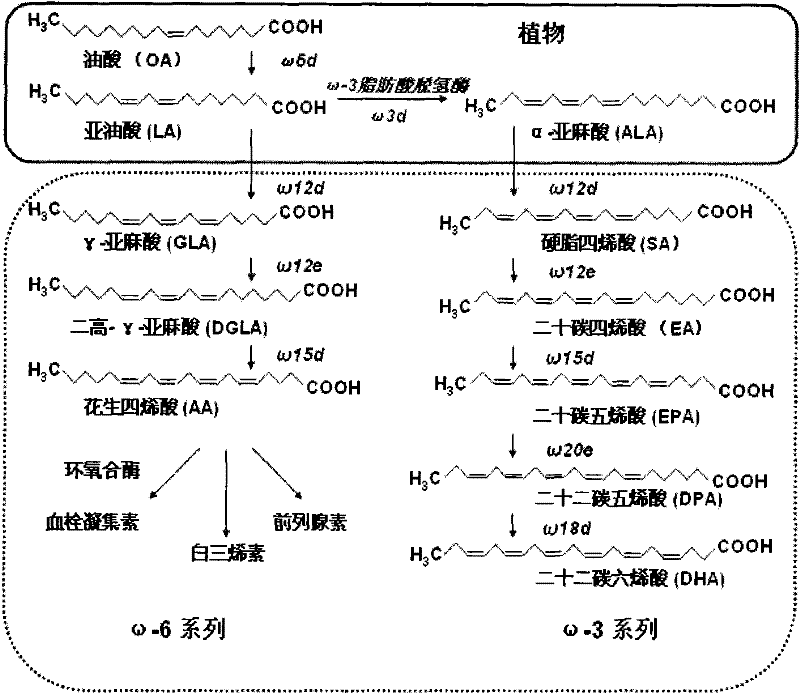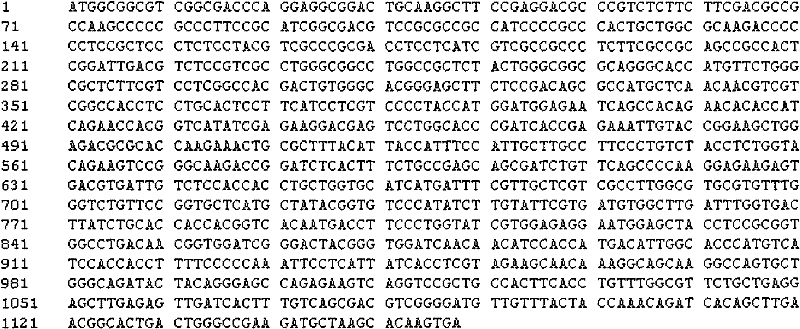A method for increasing α-linolenic acid content in transgenic plant seeds
A linolenic acid and transgenic technology, applied in botany equipment and methods, biochemical equipment and methods, plant products, etc., can solve problems such as low α-linolenic acid content, waste, and increase the metabolic burden of transgenic plants, and achieve large applications foreground effect
- Summary
- Abstract
- Description
- Claims
- Application Information
AI Technical Summary
Problems solved by technology
Method used
Image
Examples
Embodiment 1
[0046] Example 1. Using an endosperm-specific promoter to express the rice ω-3 fatty acid dehydrogenase gene to increase the content of α-linolenic acid in the seeds of transgenic plants
[0047] 1. Acquisition of rice omega-3 fatty acid dehydrogenase gene
[0048] The nucleotide sequence of rice ω-3 fatty acid dehydrogenase was searched from GenBank (GenBank number is AK071185), and primers were designed to amplify the rice ω-3 fatty acid dehydrogenase gene (OsFAD3). To facilitate vector construction, two restriction sites (underlined) were sequentially added to each pair of primers.
[0049] Rice ω-3 fatty acid dehydrogenase gene amplification primer: forward primer is F2: 5′-AA CCCGGG ATGGTTAAAGACACAAAG-3′( SmaI ) (sequence 1), the reverse primer is R2: 5'-AA GAGCTC TCAGTCTCGTTGCGAGTGGA-3′( Sac I ) (sequence 2).
[0050] Using the Trizol kit (purchased from Invitrogen), from rice Kitaake 12 days after flowering (Oryza sativaL.cv.Kitaake, Qu and Takaiwa, Plant Biote...
Embodiment 2
[0084] Example 2. Using an endosperm-specific promoter to express soybean ω-3 fatty acid dehydrogenase gene to increase the content of α-linolenic acid in transgenic plant seeds
[0085] 1. Acquisition of soybean omega-3 fatty acid dehydrogenase gene
[0086] Search soybean ω-3 fatty acid dehydrogenase nucleotide sequence from GenBank (GenBank number is AY204710), design primers to amplify soybean ω-3 fatty acid dehydrogenase gene (GmFAD3). To facilitate vector construction, two restriction sites (underlined) were sequentially added to each pair of primers.
[0087] Primers for soybean ω-3 fatty acid dehydrogenase gene amplification: the forward primer is F3: 5′-AACCCGGGATGGCGGCGTCGGCGACCCAG-3′ (Sma I), and the reverse primer is R3: 5′-AAGAGCTCTCACTTGTGCTTAGCATCTTC-3′ (Sac I).
[0088] Using the Trizol kit (purchased from Invitrogen), total RNA was extracted from soybean leaves 12 days after flowering (Shennong 25104, a gift from Professor Yu Jianzhang of Shenyang Agricultura...
PUM
 Login to View More
Login to View More Abstract
Description
Claims
Application Information
 Login to View More
Login to View More - R&D
- Intellectual Property
- Life Sciences
- Materials
- Tech Scout
- Unparalleled Data Quality
- Higher Quality Content
- 60% Fewer Hallucinations
Browse by: Latest US Patents, China's latest patents, Technical Efficacy Thesaurus, Application Domain, Technology Topic, Popular Technical Reports.
© 2025 PatSnap. All rights reserved.Legal|Privacy policy|Modern Slavery Act Transparency Statement|Sitemap|About US| Contact US: help@patsnap.com



